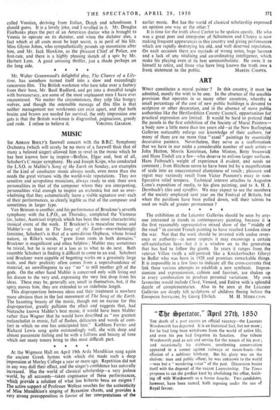ART
WHAT constitutes a mural painter ? In this country, it must be admitted, mostly the wish to be one. In the absence of the sensible provision that operates in so many other countries, whereby a small percentage of the cost of new public buildings is devoted to sculpture or other decoration, and in the absence of more publio authorities like the Hertfordshire County Council, opportunities foe practical expression are limited. It would be hard to pretend that the panels in the first exhibition of the Society of Mural Painters— a body now a little more than ten years old—at the New Burlington Galleries noticeably enlarge our knowledge of their authors, foe many of them are no more than " easel " paintings by essentially decorative painters. Nevertheless, they serve as a reaffirmation that we have in our midst a considerable number of such artists-' John Hutton, Morris Kestelman, John Minton, Betty Swanwick and Hans Tisdall are a few—who deserve to enliven larger surfaces. Hans Feibusch's weight of experience i§ evident, and needs no comment ; Ivon Hitchens seems to have been led by a magnification of scale into an unaccustomed clumsiness of touch ; pleasure and regret may variously result from Victor Pasmore's essay in non- figurative relief tempera. Technical interest attaches to Augustus Lunn's exposition of media, to his glass painting, and to A. H. J. Dernbach's tiles and sgraffito. We may expect to see the members of the society employed next year on the Festival of Britain, but when the pavilions have been pulled down, will their talents be used on walls of greater permanence ?
* * The exhibition at the Leicester Galleries should be seen by any one interested in trends in contemporary painting, because it is the first reasonably representative mixed show of the " middle of the road " in current French painting to have reached London since the war. Not that the work should be invested with undue rever- ence or authority—in some respects it may encourage a certain self-satisfaction here—but it is a window on to the generation that has had to follow the giants. In years it ranges from the veteran Villon (with a self-portrait like a Knickerbocker Glory) to Buffet who was born in 1928 and promises remarkable things. It is impossible in a few lines to indicate all the cross-currents that link these various attempts to establish a new synthesis. Impres- sionism and expressionism, cubism and fauvism, are shaken up in every combination to produce personal variations., My own favourites would include Clay& a Venard, and Esteve with splendid dazzle of complementaries. Also to be seen at the Leicester Galleries are deeply felt sculptures of children fleeing before tho European hurricane, by Georg Ehrlich. M. H. MIDDLETON.










































 Previous page
Previous page